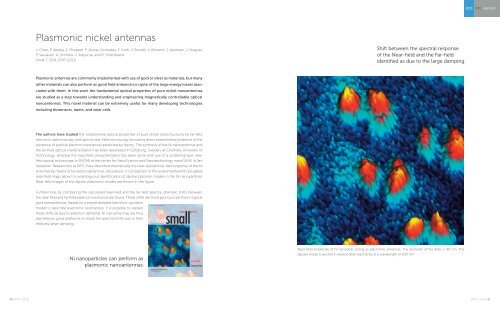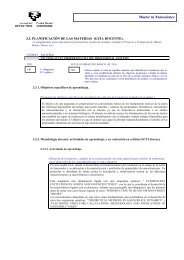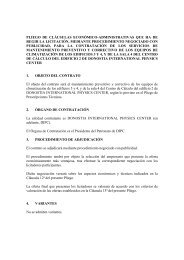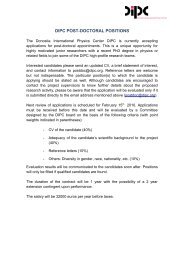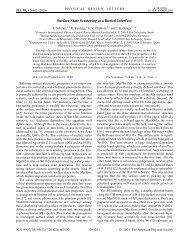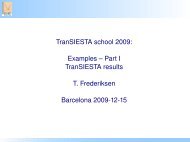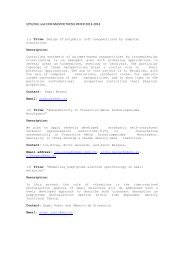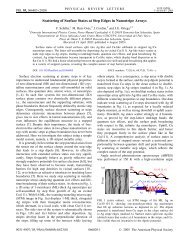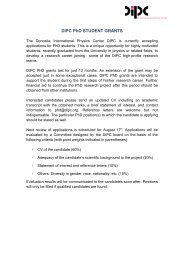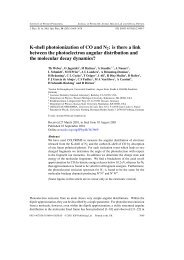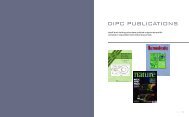Complete report - Donostia International Physics Center - Euskal ...
Complete report - Donostia International Physics Center - Euskal ...
Complete report - Donostia International Physics Center - Euskal ...
Create successful ePaper yourself
Turn your PDF publications into a flip-book with our unique Google optimized e-Paper software.
2011 DIPC Highlight<br />
Plasmonic nickel antennas<br />
J. Chen, P. Albella, Z. Pirzadeh, P. Alonso-Gonzalez, F. Huth, S. Bonetti, V. Bonanni, J. Akerman, J. Nogues,<br />
P. Vavassori, A. Dmitriev, J. Aizpurua, and R. Hillenbrand<br />
Small 7, 2341-2347 (2011)<br />
Shift between the spectral response<br />
of the Near-field and the Far-field<br />
identified as due to the large damping.<br />
Plasmonic antennas are commonly implemented with use of gold or silver as materials, but many<br />
other materials can also perform as good field enhancers in spite of the large energy losses associated<br />
with them. In this work the fundamental optical properties of pure nickel nanoantennas<br />
are studied as a step towards understanding and engineering magnetically controllable optical<br />
nanoantennas. This novel material can be extremely useful for many developing technologies<br />
including biosensors, lasers, and solar cells.<br />
The authors have studied the fundamental optical properties of pure nickel nanostructures by far-field<br />
extinction spectroscopy and optical near-field microscopy, providing direct experimental evidence of the<br />
existence of particle plasmon resonances predicted by theory. The synthesis of the Ni nanoantennas and<br />
the far-field optical characterization has been developed in Göteborg, Sweden, at Chalmers University of<br />
Technology, whereas the near-field characterization has been done with use of a scattering-type nearfield<br />
optical microscope (s-SNOM) at the center for NanoScience and Nanotechnology nanoGUNE in San<br />
Sebastián. Researchers at DIPC have described theoretically the near-field and far-field response of the Ni<br />
antennas by means of full electrodynamical calculations. A comparison of the experimental and calculated<br />
near-field maps allow for unambiguous identification of dipolar plasmon modes in the Ni nanoparticles.<br />
Near-field images of the dipolar plasmonic modes are shown in the figure.<br />
Furthermore, by comparing the calculated near-field and the far-field spectra, dramatic shifts between<br />
the near-field and far-field plasmon resonance are found. These shifts are more pronounced than in typical<br />
gold nanoantennas. Based on a simple damped harmonic oscillator<br />
model to describe plasmonic resonances, it is possible to explain<br />
these shifts as due to plasmon damping. Ni nanoantennas are thus<br />
identified as good platforms to reveal the spectral shifts due to their<br />
relatively large damping.<br />
Ni nanoparticles can perform as<br />
plasmonic nanoantennas.<br />
Near-field amplitude of Ni nanodisks acting as plasmonic antennas. The diameter of the disks is 90 nm. The<br />
dipolar mode is excited in several disks resonantly at a wavelength of 633 nm.<br />
80 DIPC 10/11<br />
DIPC 10/11 81


